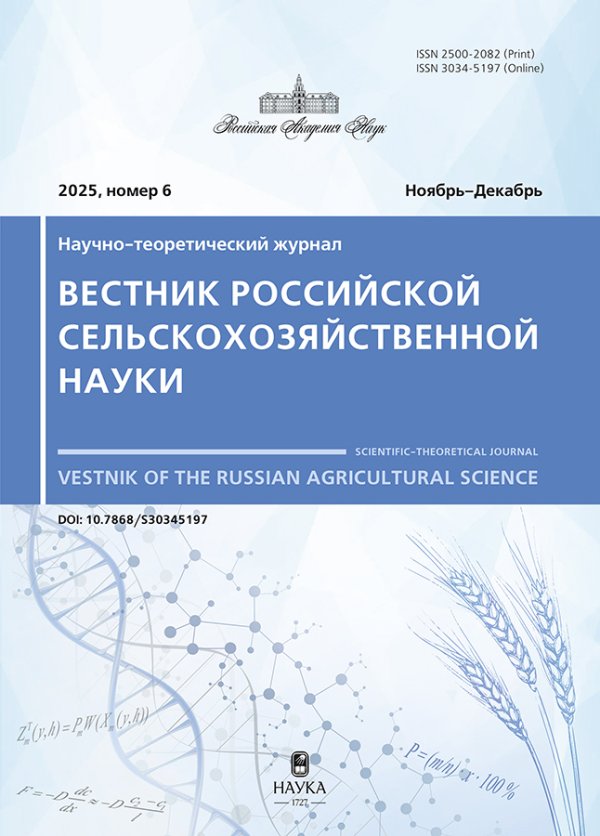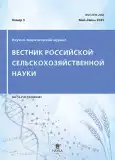No 3 (2025)
Crop Production and Selection
NEW VARIETY OF WINTER SOFT WHEAT VIMITSA FOR THE CENTRAL REGION
Abstract
 4-8
4-8


RESPONSIVENESS OF SPRING BARLEY VARIETY ZNATNY TO THE USE OF BIOLOGICAL PRODUCTS IN THE RYAZAN REGION
Abstract
 8-11
8-11


STUDY OF INTRASPECIFIC DIVERSITY OF BREEDING SAMPLES OF DURUM WHEAT IN THE CASPIAN LOWLAND OF DAGESTAN
Abstract
 12-16
12-16


INCREASING THE GERMINATION OF FLAX SEEDS BY APPLYING ACTIVATED CARBON IMPREGNATED WITH MANGANESE CARBONATE TO THE SOIL
Abstract
 17-21
17-21


WINTER HARDINESS OF CLONAL APPLE ROOTSTOCKS IN THE SOUTHERN BAIKAL REGION
Abstract
 22-27
22-27


DIFFERENTIATION OF SOIL BIOLOGICAL ACTIVITY IN INTENSIVE APPLE ORCHARDS OF CENTRAL RUSSIA
Abstract
 28-32
28-32


INFLUENCE OF ROOT AND NON-ROOT NUTRITION OF APPLE TREE ON PRODUCTIVITY AND QUALITY INDICATORS OF FRUIT
Abstract
 33-35
33-35


INTERRELATIONSHIP OF INDIVIDUAL PHYSICOCHEMICAL PROPERTIES OF BEET MOLASSES
Abstract
 36-41
36-41


NEW DOMESTIC TOMATO VARIETIES BREEDED BY FEDERAL RESEARCH CENTER OF VEGECULTURE IN IRRIGATED CONDITIONS OF DAGESTAN
Abstract
 42-47
42-47


ASSESSMENT OF CARBON DIOXIDE EMISSIONS WHEN MINIMIZING THE PRIMARY CULTIVATION OF CHERNOZEM SOIL IN THE NORTHERN FOREST-STEPPE OF WESTERN SIBERIA
Abstract
 48-54
48-54


Farming
ON THE IMPLEMENTATION OF THE PROJECT “DEVELOPMENT OF NATIONAL ACTION PROGRAMS TO COMBAT DESERTIFICATION...” FOR 14 SUBJECTS OF THE RUSSIAN FEDERATION
Abstract
 55-57
55-57


TO THE QUESTION OF FORECASTING THE PRODUCTIVITY OF WINTER RYE WITHIN THE AGROLANDSCAPE OF A MORAINE HILL
Abstract
 58-64
58-64


METHODOLOGICAL APPROACH TO THE DEVELOPMENT OF SOCIAL-ECOLOGICAL AND ECONOMIC JUSTIFICATION OF INNOVATIVE DEVELOPMENT OF THE NORTH CAUCASUS RECLAMATION COMPLEX
Abstract
 65-70
65-70


Zootechnics
POLYMORPHISM OF GH, CAST, GDF9 AND KAP1.3 GENES IN THE ANDEAN SHEEP BREED WITH SEMI-COARSE WOOL
Abstract
 71-74
71-74


DETOXIFICATION OF ANIMALS’ LIVER WITH MODISORB PLUS WHEN EXPOSED TO HEAVY METALS
Abstract
 75-78
75-78


INFORMATION TECHNOLOGIES IN AGRO-INDUSTRIAL COMPLEX
METHODOLOGICAL APPROACHES TO THE DEVELOPMENT OF DIGITALIZED TECHNOLOGIES FOR MANAGING BIOTECHNOLOGICAL PROCESSES IN PERENNIAL AGROCENOSES BY BIOECONOMIC CRITERIA
Abstract
 79-83
79-83


Veterinary entomology
SEARCH FOR CHEMICALS WITH ACARICIDAL ACTIVITY AGAINST VARROA DESTRUCTOR ACCARIDS - PARASITES OF HONEY BEES APIS MELLIFERA L
Abstract
 84-87
84-87


Processes & Machines of Agroengineer Systems
DEVELOPMENT OF AUTOMATED TECHNICAL SYSTEMS FOR STORING PLANTING MATERIAL AND REMOVING INFECTED VEGETABLE CROPS
Abstract
 88-96
88-96












